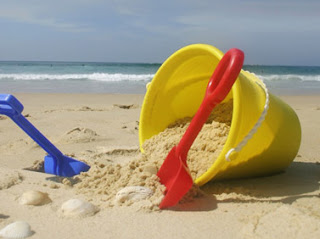
A DAY AT THE BEACH
I love summer especially once the schools have broken up.
I really enjoy being outside, wearing lighter clothes and being by the sea.
Do you love the smell of the sea?
 The smell of the sea is so evocative wherever you are on holiday and for many of us is that childhood memory.....
The smell of the sea is so evocative wherever you are on holiday and for many of us is that childhood memory.....One of the first things you notice when you arrive is that amazing smell. There is nothing quite like the smell of the sea...... salty, clean, fresh, sandy.........We often think the sea air is healthier for us and of course so bracing!
Did you know that distinctive smell has quite a bit to do with seaweed and decay......It is a sulphurous smell produced seaweed begins to break down and die.........

It is actually hydrogen sulphide produced anaerobically, which is toxic but not in the small quantities you find at the edge of the sea.
However you can also smell that amazing mix of salty water and sulphur tang when you are on a boat so it can't all be seaweed.
The oceans are full of minute phytoplankton and algae which contain and produce Dimethylsulphoniopropionate (!) DMSP used to regulate osmotic pressure in cells.
This compound can be broken down by the cells and also by bacteria giving DMS and this has a very distinct smell - that we associate with oceans.
However you can also smell that amazing mix of salty water and sulphur tang when you are on a boat so it can't all be seaweed.
The oceans are full of minute phytoplankton and algae which contain and produce Dimethylsulphoniopropionate (!) DMSP used to regulate osmotic pressure in cells.
This compound can be broken down by the cells and also by bacteria giving DMS and this has a very distinct smell - that we associate with oceans.
So a day on the beach maybe wandering along the shoreline smelling the sea is a real science lesson!
While on that wander you might find a washed up jellyfish.
 There are more and more jellyfish on our beaches and of course abroad. So there you are splashing around and suddenly you feel a stinging hot pain....yes you've brushed up against a jellyfish or tentacle portion in the water.
There are more and more jellyfish on our beaches and of course abroad. So there you are splashing around and suddenly you feel a stinging hot pain....yes you've brushed up against a jellyfish or tentacle portion in the water.The harpoon like cells penetrate your skin easily and inject venom which is designed to paralyse and kill fish and depending on the species will raise a painful welt, blister or make you very ill indeed and could kill you.
However before we all race off the beaches - the sting of most jellyfish found around British water is painful but not lethal.
So having seen that episode of Friends you run off to find someone to pee on you? Well no - because pouring fresh water - including urine - onto a jellyfish sting releases even more venom so experts suggest remove all trace of the tentacle and then rinse in plenty of salty water and very recent research suggest that hot salty water is best. ( not too sure where you would find hot salty water on a beach!)
Have I put you off going in the water? Why not stay on the beach and build a sandcastle instead!
My girls loved building sandcastles and digging very large holes with their dad - we even bought a shaped bucket to help us!
Amazingly there are people who spend their time making sand structures and there is quite an art (and some science) to it. A quick search online gives a huge amount of information about how to build the perfect sandcastle.
Here is an extract from a book Sandcastles Made Simple by Lucinda Wierenga, published by Stewart, Tabori & Chang
The list of ingredients for creating a simple sandcastle is short: sand, water and a few digging and carving tools. But that is only the start.......Sand - The first and most important thing you need to know about sand is that you can't do a thing with it unless it's wet. When you add water to grains of sand, the liquid forms "bridges" that connect the granules to one another. This is why damp sand sticks together, so you can shape and carve it.
Apparently the ideal method of building involves Mix Scoop Plop Jiggle and almost as important as understanding how to jiggle is knowing when to stop.
When the sand has stopped flowing, further jiggling will form cracks in your structure. Don't jiggle sand that has already settled into place.
Have I whetted your appetite for more about sandcastles? There is a whole blog posting about it from 2015 - you can find it here:https://sueskimo.blogspot.com/2015/06/summer-science-snippets-3.html





No comments:
Post a Comment